Young is a town in the South West Slopes region of New South Wales, Australia and is marketed as the Cherry Capital Of Australia and every year hosts the National Cherry Festival.
Young is situated on the Olympic Highway and is approximately 2 hours drive from the
Canberra area.
Young is situated in a valley, with surrounding hills. The town is named after Sir John
Young,
the Governor of NSW during 1861–67
James White was the first European settler in the district and established Burrangong Station in 1826 with a squatting claim of 100 square
miles. His story is told in the novel Brothers in Exile. Gold was found in the district in 1860. Until that time the area was called Lambing Flat, a reference to the grazing of sheep that was the main industry until mining. The town was gazetted in 1861. The goldfields produced 470,000 ounces of gold sent by escort from the fields. Up to 20,000 miners worked the fields including about 2,000 Chinese miners.
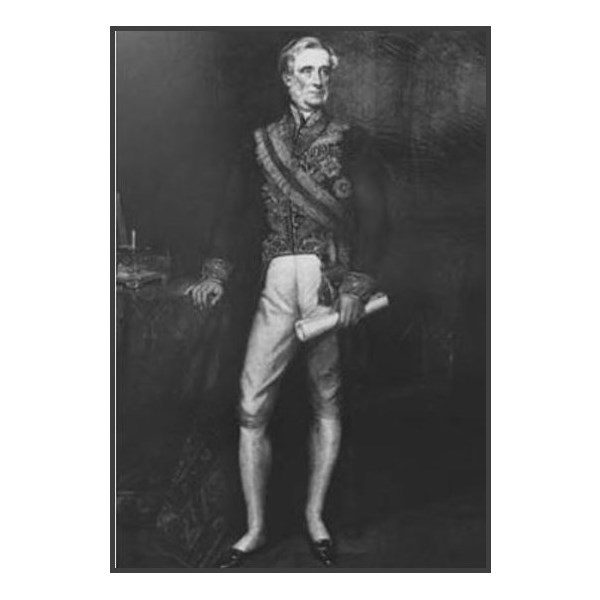
Sir John Young (1807-1876), by unknown artist
Before European settlers arrived in
Young, members of the Burrowmunditory tribe, a family group of the Wiradjuri people, lived in the region. Descendents of the Burrowmunditory clan still live in
Young.
Lambing Flat
Post Office opened on 1 March 1861 and was renamed
Young in 1863
In 1889
Young was the first town in Australia to install electricity into the streets and homes of the township,
Tamworth NSW installed electricity to the streets only the previous year.
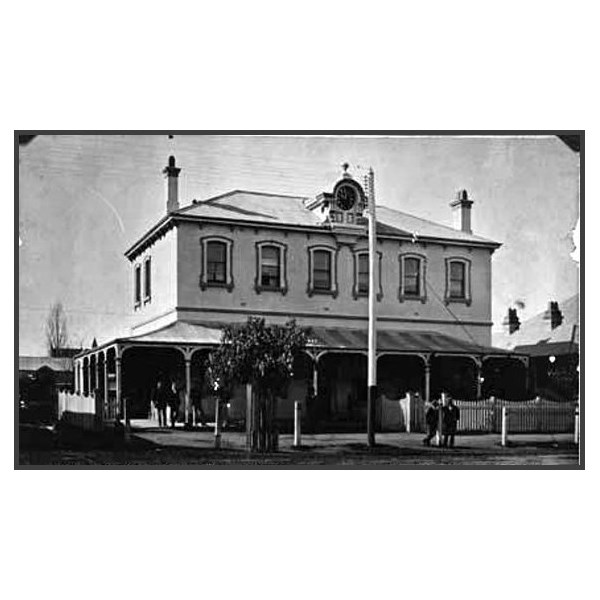
Young Post Office 1898

Main street of Young, 1960
is acknowledged as the first Local Government Area to institute a rural school bus system in New South Wales
Young Shire Council has established gardens adjacent to the site of Chinamans Dam, which is an old railway dam about 4 km south of
Young. They are intended to create an ambience similar to the Japanese Gardens at Cowra. Chinamans Dam, with an initial capacity of over 2 million imperial gallons when it was in railway use, is situated at a very small place called Pitstone on Sawpit Gully. The story goes that the dam was built in the 1860s by Dutch brothers, Herman and John Tiedemann, to provide
water for the sluicing of their Victoria
Hill gold claims. At some time in the 1870s,
the brothers sold the area, including the dam, to a Chinese group who worked the site.
The story of the dam as a railway facility began in 1882 when the NSW Railway Commissioners gave notice of the intention to build the first part of the
Blayney-
Demondrille railway. To provide
water for its steam locomotives, the Commissioners decided to provide a dam and pump
water from it to a facility, known as
Young Tank, at the 246-mile post. It is not known whether the railways enhanced the existing dam or built a new facility.
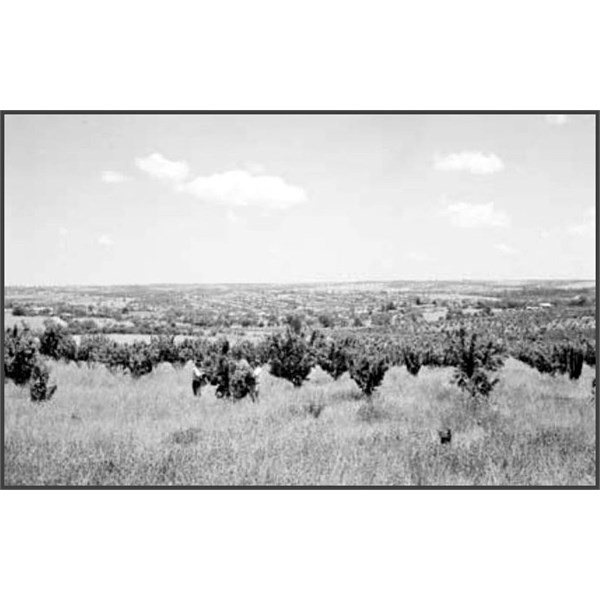
Harvesting cherries at Young 1950
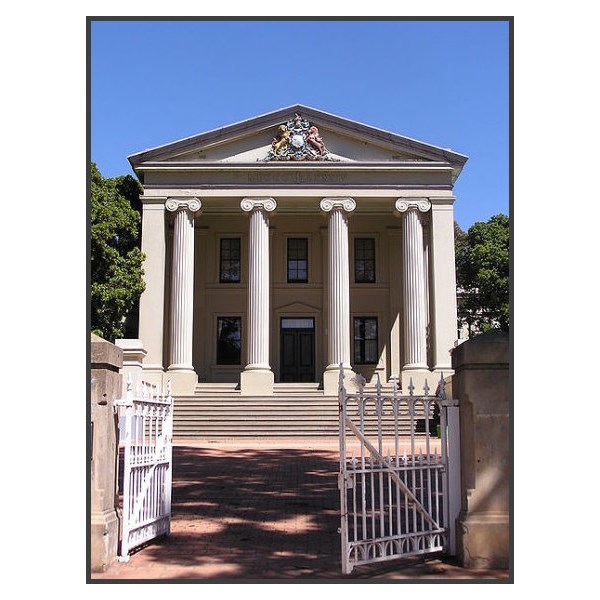
Young courthouse built in 1886 but transferred to the Department of Education in 1925
From 1885 to 1901, locomotives stopped at
Young Tank to replenish their
water. In 1901, watering facilities were built at
Young Station. The supply of
water was obtained from Chinamans Dam. The capacity of the dam was enlarged in 1911.
The dam was a popular spot for swimming. Whilst officially frowned upon, it was tolerated.
Following the connection to the South West Tablelands
Water Supply Scheme, which provided
water from Burrinjuck Dam, the railways ceased to draw
water from Chinamans Dam after 1936. The site was returned to the Crown in 1962 and in the following year, a 36-acre reserve was established and the Shire Council appointed as Trustees. The dam has since been enlarged
From November 1860 through to June 1861 anti-Chinese miners attacked Chinese gold miners in the area, now known as the infamous Lambing Flat riots. As gold became scarce, European miners began to resent what they saw as the greater success of the more industrious Chinese, and hence many Chinese miners were attacked, robbed and killed. The anti-Chinese rebels rallied in numbers of up to 3,000. Eventually the rioters were controlled, Chinese miners had their claims restored to them, but the New South Wales Parliament passed the Chinese Immigration Bill which restricted the number of Chinese that could be brought into New South Wales on any ship and imposed a tax per head on entry.
In ten months of unrest at Burrangong, the most infamous riot occurred on the night of 30 June 1861 when a mob of perhaps 3,000 drove the Chinese off the Lambing Flat, and then moved on to the
Back Creek diggings, destroying tents and looting possessions.[citation needed] About 1,000 Chinese abandoned the field and set up
camp near Roberts'
homestead at Currowang sheep station, 20 km away. There were two triggers for the violence: in
Sydney the Legislative Council rejected the anti-Chinese bill, and a false rumour swept the goldfield that a new group of 1,500 Chinese were on the road to Burrangong. The police arrived in the days that followed, identified the leaders of the riot, and three were arrested two weeks later. The mob's reaction was an armed attack on the police
camp by about a thousand miners on the night of 14 July, which the police broke up with gunfire and mounted sabre charges, leaving one rioter dead and many wounded.
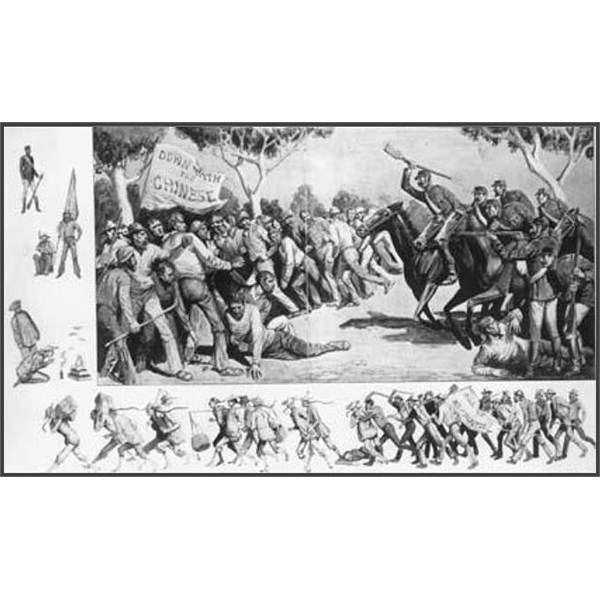
Chinese in Lambing Flat riots, December 1860
The police briefly abandoned the field, but then a detachment of 280 soldiers, sailors and police reinforcements arrived from
Sydney and stayed for a year. The Chinese were reinstated on the segregated diggings, the ringleaders of the riots were tried and two were gaoled. At the end of the affair, Burrangong was quiet and the Chinese were still there.

The Roll Up banner
The Roll Up banner around which a mob of about 1,000 men rallied and attacked Chinese miners at Lambing Flat in June 1861.
A banner from the period, painted on a tent-flap in 1861, is now on display at the Lambing Flat museum in
Young, New South Wales. Bearing a
Southern Cross superimposed over a St. Andrew's Cross with the inscription, 'Roll Up - No Chinese', the banner has been claimed by some as a variant of the Eureka Flag. It served as an advertisement for a public meeting that presaged the infamous Lambing Flat riots later that year. Painted by a Scottish migrant, it is a testimony to the transfer of cultural practices and values through migration. Though it has been claimed to be an example of Chartist art, the Chartist movement was not racial in nature and sought only to protect the poor from the rich. Nevertheless, along with the Eureka Flag it is a rare example of an historic Australian banner designed to rally support to a cause.
.